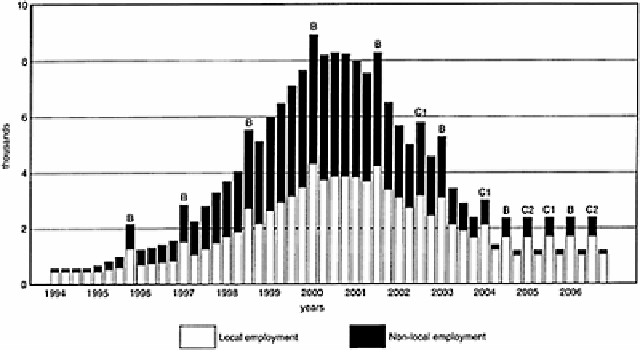Environmental Engineering Reference
In-Depth Information
prediction of the socioeconomic impacts drew directly on the findings from the Sizewell
B monitoring study. Figure 7.6 provides an overview of the cumulative employment
impacts of the operational Sizewell B plus the construction of Sizewell C (with two
reactors, C1 and C2). The regular peaks in the figure are the refuelling intervals.
However, this proposed follow-on project fell victim to the abandonment of the UK
nuclear power station programme.
Figure 7.6
Predicted local
employment impacts of Sizewell B
operational station and Sizewell C
construction project (with reactors C1
and C2). (
Source:
Nuclear Electric
1993, 1994.)
7.6
Summary
A mediation of the relationship between a project and its environment is needed
throughout the life of a project. Environmental impact assessment is meant to establish
the terms and conditions for project implementation; yet there is often little follow-
through to this stage and even less follow-up after it. Arts (1998) concludes, after a
thorough examination of “ex-post evaluation of EIA”, that in practice it is lagging behind
the practice of EIA itself. Few countries have made arrangements for some form of
follow-up. In those that have, experience has not been too encouraging—reflecting
deficiencies in often over-descriptive EISs, inadequate techniques for follow-up,
organizational and resource limitations, and limited support from authorities and project
proponents alike. Yet many projects have very long lives, and their impacts need to be
monitored on a regular basis. Morrison-Saunders et al. (2001) show how this can bring
positive outcomes for different stakeholders. Figure 7.7 shows the benefits not only to the
proponent and the community (as exemplified by the Sizewell B case study), but also to

Search WWH ::

Custom Search